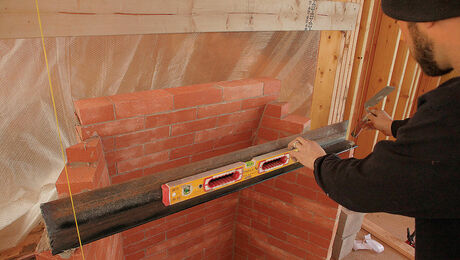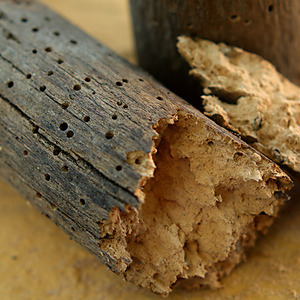Dear Freinds: I’m a moderately retired Civil Engineer who just installed a new bathroom and have a plumbing question. In past years I had always used copper tubing for my home plumbing projects. Recently my friends have raved about PEX tubing and its many advantages. It isn’t affected by freezing; lasts forever; is flexible, etc., etc. Well I went out and bought some “Wirsbo” tools and Worsbo PEX tubing, and connected up all the fixtures in my bathroom. HOWEVER, when I was half finished I noticed on the instructions for the Wirsbo expansion tool a statement that says that if a “qualified” trained technician makes the connections, they are guaranteed for ten years. If a non-qualified technician makes the connections, they are only guaranteed for one year. Now copper connections will last the life of the house. Do PEX connections come loose and fail? Has anyone found a failed PEX connection? A ten-year life for a “behind-the-wall” plumbing connection just isn’t long enough, and a one year life is just ridiculous. Any information on this would be appreciated. Note that there are several different types of PEX on the market. The Wirsbo pex uses a PEX sleeve over the fitting end, and the entire tubing and sleeve is expanded with a special tool to fit over the metal fitting. The fitting is quickly inserted and the PEX shrinks back down with a “death grip” over the metal fitting. Supposedly it will never leak . . . . but does it?
Discussion Forum
Discussion Forum
Up Next
Video Shorts
Featured Story

Learn how to fight wood-boring beetles and prevent home infestations with expert advice from Richard D. Kramer, an authority in pest control.
Featured Video
Video: Build a Fireplace, Brick by BrickHighlights
"I have learned so much thanks to the searchable articles on the FHB website. I can confidently say that I expect to be a life-long subscriber." - M.K.

















Replies
Exclusive Remedy
It is expressly agreed that the exclusive remedies under this limited warranty shall be at the option of Wirsbo Company to" issue a refund, repair or replace any article which is proven to be defective. Allowances made to customers for transportation, labor, repairs, or any other work, are at the sole discretion of Wirsbo Company, and must be authorized in writing, in advance by Wirsbo Company.
when it comes right down to it, what difference does it make ? they are only going to reimburse you for the new fitting if it fails. as far as labor to access or repair it ?
dream on........
wirsbo is a great name, nonetheless. there are a lot of plumbers out there betting on that.
carpenter in transition
Oh give me a home where the Wirsbo roams.
I agree it is good stuff.
For the original poster, here's my take on various piping technologies:
Poly-butylene plastic water pipes were on the market for some 25-30 years. The manufacturers lost a few class action suits because the original plastic fittings failed over time. Poly-B pipe was pulled off the market a few years ago.
Anyone here know if Poly-B installs with metal fittings are also failing?
Pex (cross-linked polyethylene) is the base component of Wirsbo's and other manufacturers PEX water lines. The fittings usually are metal, with copper or plastic crimp rings.
Copper pipes and fittings have been around longer than most of us have been alive. Provided the installer wiped the flux after sweating his joints, and the water is not too corrosive, and there's no galvanic action with iron pipes, old copper installs are holding up fine. If the joints were not wiped, the install can fail in four to five decades.
Edited 4/26/2005 1:45 am ET by Pierre1
Anyone here know if Poly-B installs with metal fittings are also failing?
Yes, I have a house full of the stuff and HATE it. Poly-B on copper fittings with metal compression rings holding them in place. You fix one bad joint and a few days / weeks / months later, the next one down the line goes.
Are you cutting out the Poly-B and replacing with PEX, using Poly-B to PEX conversion adaptors, or going about it another way?
I'm cutting out the Poly-B, and using compression fittings to PVC adapters and regular PVC. The repairs hold just fine. However, anytime the existing Poly-B is disturbed, the next connection down the line may start to leak a few days to months later.
Provided the installer wiped the flux after sweating his joints
Pierre- could you elaborate a bit on that and the mechcanical/chemical involvement.
Thanks
sobriety is the root cause of dementia.
"could you elaborate a bit on that and the mechcanical/chemical involvement."
What should get wiped off is the flux residue, once the sweated joint has cooled. This stuff is a corrosive agent that over time leads to pinholing (from personal observation).
You can experiment with this if you get the chance. It actually does not take too many weeks for the chemical reaction of acid flux paste on copper pipe work to show visible signs of activity.
While doing home inspections, I've noticed that in older neighbourhoods, some houses' copper pipe fittings are practically seeping water, other fittings have minute water droplets slowly diffusing to the outside. These weak areas are sticky to the touch, from what appears to be old flux residue (you know how flux drips from a joint...well, the corrosion follows the same pattern).
Other old homes on the same street are fine, with little more than dry tarnish to show for their age. My conclusion is that it's not the water, or the climate, but the care taken to wipe down the install.
I've refused to do a repair on one place where the copper pipes were so badly corroded that imo the house needed a complete R&R the owners did not want to do. Just looking at these pipes made me nervous. In another case, I reported a similar condition to a prospective home buyer, who withdrew his conditional offer to purchase. That realtor hates me now.
Caveat: I'm neither a plumber, chemist or mechanical engineer, but I know where to look. :)
Well thanks for the info.
How might one remove flux remnant after cooling?
be inquiring minds just got to know
sobriety is the root cause of dementia.
I use a wet rag, kept in a pail nearby. Good fire suppression backup to my ABC extinguisher. ;)
What i meant to say was how might one remove, say, 1 month old dried flux on the soldered joint.
I'd never heard this before. Chalk another up forTaunton University of Knowledge FHB Campus at Breaktime.
be unified
sobriety is the root cause of dementia.
Hot, soapy water.If I understand correctly, the fraction of the flux that really needs to be removed is water soluble and comes off fairly easy. The problem is that it is hygroscopic and will absorb moisture out of the air to continue its attack on the copper. Any paste flux residue that didn't get hot enough to turn black is still corrosive, but not nearly as corrosive as the water soluble stuff. So a wet rag will remove the really damaging flux residue, while a hot, soapy rag and a little elbow grease will remove all of it.
The older stuff is not water soluble. The last time that got some I "reached" for the the water soluble, but ended up with older stuff.
>> The older stuff is not water soluble.Yes, I know it's not water soluble out of the jar, but after it's been heated to soldering temperature (and often beyond, if you're no better with a torch than I am), much of the residue is water soluble, and it's the water soluble part that really needs to be cleaned off.
Dear Wonderful Friends of Breaktime: I never thought my question on PEX would stirr up so much interest, or generate so much information. I wish I had read all your comments before I started my plumbing project. You folks are GREAT. Thanbk you one and all.
What Uncle Dunc says.
One of those green 3M scouring pads, with soapy water, would loosen the crusty stuff easily enough - finish off with the rag.
Thank ye all.
sobriety is the root cause of dementia.
I think Pierre is on to the key. PEX manufacturers (and their insurers!) are loath to be on the receiving end of a class-action suit a la ploybutylene piping. PEX seems superior in every way and the things I see it used for: ski bases, dog sled runners, tupperware, etc that see physical abuse AND -55F temps AND 200F temps AND my understanding of its chemical resistence and compatibility all indicate that the PEX should out last everything except maybe lead piping (I've removed 350-year-old lead piping in Holland and it looked great. Toxic, but great.)
So that warranty sounds like it was written by insurers and/or bean-counting lawyers and not by a technical group.
Consider that when you plumb with metal, you don't get any warranty. And those Chinese galvanized fittings of 15 years ago that were so crappy - pinhole leaks and off-spec thread sizes? If you have those, what do you do? Sue Home Depot for stocking crap? Sue the Chinese Communist party for overseeing their heavy industries? Or just suck it up and pay out of your own pocket?
P.S. Welcome. And IMO, some Civils can make good off-hours plumbers.
"Consider that when you plumb with metal, you don't get any warranty."Actually you do get a 50 yr warranty with copper.http://www.copper.org/applications/plumbing/restools/wrnty/war_doc_txt.htmBut there is not much left after you get past the exclusions.
P.S. Welcome. And IMO, some Civils can make good off-hours plumbers.
Cool! I'm a civil PE as well. Although I don't know too much about interior plumbing, I can handle all the outside and subsurface stuff.....
FWIW, I have enough faith in PEX, and it's track record in Europe, that I am using it for two floors of radiant heat and ALL of my potable water plumbing in the new house I'm building. It's just too good to ignore. Make all your fixture connections homeruns to a manifold, run it places that would be impossible or difficult with copper, snake it through existing walls, etc etc. Great stuff. Wirsbo is one of the best, as is Rehau and Vanguard. I'm using Mr. Pex (Safelink) for my radiant heat and Vanguard for the potable water.
As for the warranty - the heck with it. Fittings and tubing are cheap, and you sure don't get a warranty with copper (and it can corrode and leak, so it's not foolproof either).
As an engineer, your're probably familiar with trade-offs in material selection for projects and the concept of interfaces in systems. My experience in systems engineering tells me that 95% of all problems occur at interface points, be they electrical, hydraulic, pneumatic, or mechanical. Places where stuff plugs together, or where dissimilar materials contact are where you will usually find the problems.
Now, ask yourself a simple question: If a house is plumbed with the same material throughout, will it be more reliable than a house plumbed with two different materials mechanically joined at dozens of interface points? And which has higher reliability, a soldered, metal-metal joint, or a mechanically-crimped platic-metal joint?
PEX is often portrayed as a point-point plumbing system when it actually has _mechanical_ crimped connections at almost every fitting. In one house I saw, the plumber who installed the PEX used elbow fittings and splice connectors so the result was almost the same as a traditional sweated copper install. There were over a dozen mechanical crimped joints in the shower area alone!
I hate to sound like a dinosaur, but this stuff sounds too good to be true. I'll stick with proven technology.
"I hate to sound like a dinosaur, but this stuff sounds too good to be true. I'll stick with proven technology."
Are you suggesting that PEX has either not been proven or has been disproven in its use during the past 25-30 years? I know you do not walk everywhere you go. Sometimes you trust newer technologies like the automobile, over your feet. :)
I don't believe they're saying this material will fail in one year or ten. What they're saying is that if the installation is done by a technician trained and certified there is SOME guarantee that it will be installed in accordance with methods approved by the manufacturer. If done by someone not certified, they have no way of knowing if the install was done correctly, thus the difference in warranty time. While relatively new in the US, PEX has been in use successfully in Europe for over 40 years.